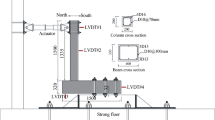Abstract
The research reported in this paper is a contribution in understanding the epoxy injection retrofitting technique to strengthen the existing RC cracked members. This technique consists of injecting epoxy resin adhesive in a cracked beam to increase the stiffness and the strength. A total of six full scale RC beams were constructed with the same material using the same mix and water-cement ratio. The beams were tested until the width of cracks reached a limiting value of 1 mm. The beams were then repaired with the epoxy injection technique. After 3 days of water curing, the beams were tested again and loaded till the failure occurred. A considerable enhancement in the load carrying capacity was observed in the beams after the retrofitting. A reduction in deflection was also observed due to the injection of epoxy. These results clearly demonstrate the effectiveness of the proposed technique in repairing the RC members for strengthening the existing structures.













Similar content being viewed by others
References
ACI Committee 224 (2007) Causes, evaluation, and repairs of cracks in concrete structures (224.1R-07). American Concrete Institute, Farmington Hills, p 22
ACI Committee E706 (2003) Structural crack repair by epoxy injection (ACI RAP bulletin 1). American Concrete Institute, Farmington Hills, p 5
ACI Committee E706 (2003) Crack repair by gravity feed with resin (ACI RAP Bulletin 2). American Concrete Institute, Farmington Hills, p 4
ACI Committee 546R-96 (1996) Concrete repair guide. American Concrete Institute, Michigan
Calder AJJ, Thompson DM (1998) Repair of cracked reinforced concrete: assessment of corrosion protection. Transport and Road Research Laboratory, Department of Transport, Research Report 150
Chapdelaine F, Beaupre D (2000) Pumping fiber-reinforced wet-mix shotcrete. Am Shotcrete Assoc Mag 2(2):36–37
Craeye B, Geirnaert M, Schutter GD (2011) Super absorbing polymers as an internal curing agent for mitigation of early-age cracking of high-performance concrete bridge decks. Constr Build Mater 25(1):1–13
David E, Djelal C, Buyle-Bodin F (1998) Repair and strengthening of reinforced concrete beams using composite materials. In: 2nd international PhD symposium in civil engineering, Budapest
Dritsos S, Pilakoutas K (1994) Repair/strengthening techniques for structurally damaged RC columns. In: Proceedings of the 5th US national conference on earthquake engineering 3, Chicago, IL, pp 667–676
Filiatrault A, Lebrun I (1996) Seismic rehabilitation of reinforced concrete joints by epoxy pressure injection technique, seismic rehabilitation of concrete structures SP-160
French CW, Thorp GA, Tsai WJ (1990) Epoxy repair techniques for moderate earthquake damage. ACI Struct J 87(4):416–424
Frosch RJ (1999) Another look at cracking and crack control in reinforced concrete. ACI Struct J 96:437–442
Gergely P, Lutz LA (1968) Maximum crack width in reinforced concrete flexural members. Causes, mechanism and control of cracking in concrete, SP-20. American Concrete Institute, Farmington Hills, pp 87–117
Georgopoulos T, Dritsos SE (1994) A steel jacketing technique for strengthening RC columns. In: Proceedings of the 10th European conference on earthquake engineering, Vienna, Austria, pp 2275–2280
Ghobarah A, Said A (2001) Seismic rehabilitation of beam–column joints using FRP laminates. J Earthq Eng 15(1):113–129
Hashemi S, Al-Mahaidi R (2012) Experimental and finite element analysis of flexural behavior of FRP-strengthened RC beams using cement-based adhesives. Constr Build Mater 26(1):268–273
Hashim SA (1999) Adhesive bonding of thick steel adherents for marine structures. Mar Struct 12:405–423
Heere R, Morgan DR (2002) Determination of early-age compressive strength of shotcrete. Am Shotcrete Assoc Mag 4(2):28–31
Issa CA, Debs P (2007) Experimental study of epoxy repairing of cracks in concrete. Constr Build Mater 21(1):157–163
Kachlakev D, McCurry DD (2000) Behavior of full-scale reinforced concrete beams retrofitted for shear and flexural with FRP laminates. Compos B 31:445–452
Karbhari VM (2001) Materials considerations in FRP rehabilitation of concrete structures. J Mater Civil Eng 13(2):90–97
Karayannis C, Chalioris K, Sideris K (1998) Effectiveness of RC connection repair using epoxy resin injections. J Earthq Eng 2(2):217–240
Minoru K, Toshiro K, Yuichi U, Keitetsu R (2001) Evaluation of bond properties in concrete repair materials. J Mater Civil Eng 13(2):98–105
Nikoupour H, Nehdi M (2011) Shear repair of RC beams using epoxy injection and hybrid external FRP. Mater Struct 44:1865–1877
Prasad NP (2005) Enhancement of flexural capacity of undamaged RC column by a composite steel caging technique. M Tech Thesis, Indian Institute of Technology Kanpur, India
Sabnis GM (1996) Seismic rehabilitation of concrete structures. American Concrete Institute, Special Publication 160
Said AM, Nehdi ML (2004) Use of FRF for RC frames in seismic zones: part I, Evaluation of FRP beam-column joint rehabilitation techniques. Appl Compos Mater 11(4):205–226
SIKA (2002) Sika data book 2002, Sika Near East, S.A.L., Beirut, Lebanon
Shash AA (2005) Repair of concrete beams—a case study. Constr and Build Mater 19(1):75–79
Toutanji H, Zhao L, Zhang Y (2006) Flexural behaviour of reinforced concrete beams externally strengthened with CFRP sheets bonded with an inorganic matrix. Eng Struct 28:557–566
Author information
Authors and Affiliations
Corresponding author
Rights and permissions
About this article
Cite this article
Ahmad, S., Elahi, A., Barbhuiya, S. et al. Repair of cracks in simply supported beams using epoxy injection technique. Mater Struct 46, 1547–1559 (2013). https://doi.org/10.1617/s11527-012-9996-x
Received:
Accepted:
Published:
Issue Date:
DOI: https://doi.org/10.1617/s11527-012-9996-x




